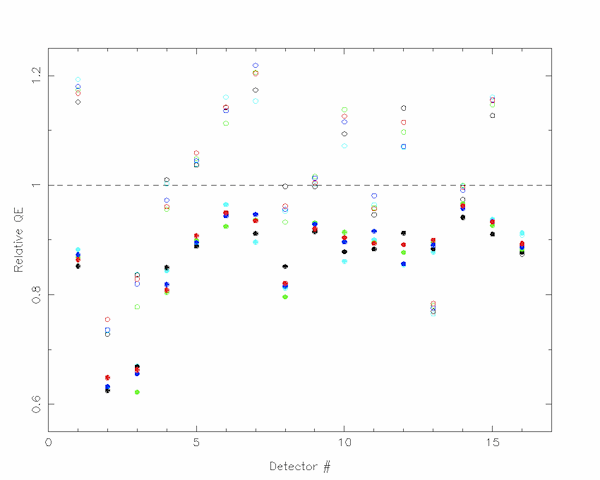VISTA gain/read noise
Read noise and gain measurements with each detector listed on a separate row and each column representing a different filter. The results are consistent across the board with the possible exception of #16 problems and #13 which is quite non-linear. H and K are not included as the linearity sequences saturated too early to be useful for this recipe.
Readout noise results
# NB118 Z Y J
1 22.903 22.782 22.791 27.231
2 22.394 26.694 22.007 26.665
3 20.708 24.783 20.186 25.402
4 21.734 25.758 21.145 27.222
5 21.770 25.989 21.586 28.364
6 21.258 25.579 21.504 26.241
7 24.378 23.737 19.814 24.505
8 21.732 26.474 21.853 27.160
9 19.418 18.838 18.401 19.209
10 24.888 24.740 24.280 25.786
11 24.039 23.504 23.543 25.512
12 25.233 24.403 20.398 25.153
13 26.898 29.973 24.128 25.341
14 19.780 19.652 14.989 20.558
15 17.113 19.643 16.650 17.380
16 23.477 19.398 17.497 22.714
Gain results
# NB118 Z Y J Average
1 3.648 3.628 3.630 3.717 3.66
2 4.280 4.251 4.206 4.247 4.25
3 3.957 3.947 3.858 4.045 3.95
4 4.154 4.102 4.041 4.335 4.16
5 4.160 4.139 4.125 4.517 4.24
6 4.063 4.074 4.110 4.179 4.11
7 3.882 3.780 3.787 3.903 3.84
8 4.153 4.216 4.176 4.326 4.22
9 4.639 4.500 4.396 4.589 4.53
10 3.964 3.940 3.867 4.107 3.97
11 4.594 4.492 4.499 4.876 4.62
12 4.018 3.886 3.898 4.006 3.95
13 5.140 5.728 5.764 6.054 5.67
14 4.725 4.695 4.774 4.911 4.78
15 4.088 3.754 3.977 4.152 3.99
16 5.608 4.634 4.180 5.426 4.96
median gain 4.19 (cf. 4.3 for wfcam)
Effective gain in science products
For individual processed science images the internal gain normalisation done when flatfielding yields data products with the same gain value (the median gain of 4.19) for each detector. In principle, at least, because stacked pawprint science images are averages, clipped as necessary, the overall effective gain for a dither stacked image is simply the original single image gain multiplied by the number of images used in the stack. Complexities arise because not all stacked image pixels were made from the same number of sub-components (e.g. due to dithering or clipping rejection) and this is further muddied by the necessary interpolation used in dither stacking. This latter leads to correlated pixel noise with, in general, a spatially variable noise covariance matrix across each stacked detector image. For tile images both issues are also present, only more so, compounded even further by the complex pattern of sub-images forming the tile, plus the global reinterpolation of the pawprints to a tangent plane projection. The associated confidence maps encode the complexity of the pattern caused by the effective number of exposures but not the subtleties introduced by the pixel interpolations.
Sensitivity from flats
The following figure shows the internal gain as calculated from the flats (open circles) and the sensitivity derived (filled circles) using the gain from the table above (Z: cyan, Y: black, J: blue, H: green, Ks: red).

The internal gain as derived from the flats is provided in the following table which for each chip and filter gives the median value of the flat and its mean absolute deviation in parenthesis.
| Chip | Z | Y | J | H | Ks | | 1 | 1.193 (0.013) | 1.152 (0.004) | 1.180 (0.015) | 1.174 (0.015) | 1.168 (0.002) | | 2 | 0.735 (0.010) | 0.728 (0.029) | 0.736 (0.015) | 0.755 (0.007) | 0.755 (0.012) | | 3 | 0.837 (0.032) | 0.836 (0.023) | 0.820 (0.036) | 0.778 (0.018) | 0.829 (0.011) | | 4 | 1.003 (0.012) | 1.010 (0.028) | 0.973 (0.009) | 0.956 (0.010) | 0.961 (0.012) | | 5 | 1.039 (0.032) | 1.037 (0.027) | 1.045 (0.015) | 1.049 (0.019) | 1.059 (0.015) | | 6 | 1.161 (0.033) | 1.142 (0.014) | 1.136 (0.018) | 1.113 (0.023) | 1.143 (0.010) | | 7 | 1.154 (0.016) | 1.174 (0.008) | 1.219 (0.012) | 1.206 (0.005) | 1.204 (0.003) | | 8 | 0.952 (0.017) | 0.998 (0.011) | 0.956 (0.023) | 0.933 (0.012) | 0.962 (0.019) | | 9 | 1.002 (0.003) | 0.998 (0.004) | 1.013 (0.005) | 1.016 (0.001) | 1.004 (0.001) | | 10 | 1.072 (0.002) | 1.094 (0.009) | 1.116 (0.011) | 1.138 (0.005) | 1.126 (0.009) | | 11 | 0.964 (0.006) | 0.946 (0.045) | 0.981 (0.014) | 0.959 (0.028) | 0.957 (0.019) | | 12 | 1.069 (0.021) | 1.141 (0.031) | 1.071 (0.007) | 1.097 (0.006) | 1.115 (0.017) | | 13 | 0.765 (0.017) | 0.770 (0.005) | 0.776 (0.020) | 0.780 (0.022) | 0.784 (0.018) | | 14 | 0.999 (0.002) | 0.974 (0.004) | 0.991 (0.003) | 1.000 (0.005) | 0.996 (0.004) | | 15 | 1.161 (0.015) | 1.127 (0.017) | 1.156 (0.011) | 1.147 (0.018) | 1.155 (0.016) | | 16 | 0.909 (0.002) | 0.874 (0.006) | 0.883 (0.004) | 0.880 (0.002) | 0.890 (0.004) |

